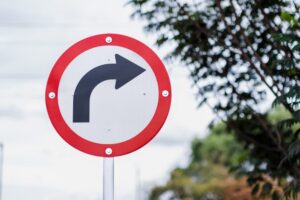
There’s no one-size-fits-all answer to this question. These collisions can be complicated, involving anything from traffic violations to brake failures.
A T-bone accident, also known as a side-impact collision, happens when one vehicle crashes head-on into the side of another, creating the shape of a “T.” Determining fault requires understanding the nuances of traffic laws, what happened in those critical moments before the crash, and which driver acted negligently.
If you’ve suffered injuries in a T-bone accident, understanding fault is your first step toward receiving compensation. You should always have an experienced car accident attorney evaluate your case. Let’s unpack some factors that go into determining who’s at fault.
While each collision is different, the following are some common locations for T-bone crashes:
So, who’s to blame for a T-bone collision? The answer usually lies in which driver failed to follow traffic laws. Let’s break it down:
The first question that often arises is whether one driver violated a traffic law or signal, such as running a red light or ignoring a stop sign. If a driver ran through a red light or failed to stop at a stop sign before the accident, they will likely be at fault, as traffic signals are specifically designed to manage the flow of vehicles and avoid such collisions.

Intersections are the most common setting for T-bone accidents, and right-of-way rules are essential in these spaces. Right-of-way laws dictate which driver can legally proceed, and failing to yield is a frequent cause of T-bone collisions.
For example, when one driver is turning left across traffic, and another is approaching from the opposite direction, the turning driver must yield to the oncoming car. If they don’t, they should be liable for the accident. Similarly, when two drivers reach an intersection with stop signs, the driver who arrived first or is to the right typically has the right of way. Disobeying these rules often leads to collisions, placing fault on the driver who failed to yield properly.
A driver who is speeding or driving aggressively has a reduced ability to react to traffic signals, stop signs, or the actions of other drivers. Even if they had the right of way, speeding can make them at least partially liable for the accident. For instance, if a driver is traveling significantly over the speed limit through an intersection and another driver makes a legal left turn, the speeding driver may be held partially responsible for the collision. Similarly, aggressive driving or swerving through traffic can contribute to the accident’s severity, leading to shared liability.
The following is important evidence to determine whether another driver engaged in any of the above conduct to cause your T-bone accident.
Eyewitness accounts can be instrumental in determining fault in a T-bone accident. Bystanders, other drivers, or pedestrians who witnessed the collision can help paint a clear picture of what transpired. They can provide important details, such as whether one driver ran a red light or if a vehicle appeared to be speeding. Insurance companies and law enforcement often use their unbiased accounts to verify the events leading up to the accident. When both drivers present conflicting versions of the story, eyewitness testimonies can be the deciding factor in establishing fault.
When police arrive at the scene of a T-bone accident, they often document their observations and statements from drivers and witnesses. Police reports are frequently used in insurance claims as objective accounts of the accident. They may include the officer’s assessment of who violated traffic laws, whether any citations were issued, and initial thoughts on which driver might have been at fault. While police reports are not always definitive in assigning liability, they carry significant weight and can guide insurance adjusters in their fault determination process.

In today’s age of technology, video evidence is becoming increasingly common in car accident cases. Dashcams or nearby surveillance cameras can prove who caused a T-bone accident. Footage can show whether a driver ran a red light, failed to yield, or was driving recklessly.
This kind of evidence can be invaluable, particularly in cases where fault is disputed. Insurance companies and attorneys often rely heavily on video evidence to determine liability, making it one of the most persuasive tools in establishing fault.
Your car accident lawyer can collect all available evidence to prove liability for your collision.
The time after a crash can be confusing, though what you do can either help or hurt a future legal claim.
Filing a police report is essential after any T-bone accident. This report will serve as key evidence for your case and insurance claim. If the police did not come to the scene, be sure to call and report the crash as soon as possible.
If you’ve been in a T-bone collision, it’s time to talk to a car accident attorney. They can ensure you seek any compensation you’re entitled to, especially if the other party is disputing fault or the accident involves severe injuries. Don’t tackle the legal process alone—an experienced car accident lawyer can make all the difference.

When a T-bone accident happens, the fault isn’t always clear-cut. Whether it’s running a red light or failing to yield, determining who’s responsible can make or break your case. This is where a personal injury lawyer steps in. They’ll sift through all the details, leaving no stone unturned, and make sure you’re in the best possible position to claim what’s rightfully yours.
Call a law firm near you to schedule a free consultation. Don’t wait, as there may be time limitations for filing a claim.
